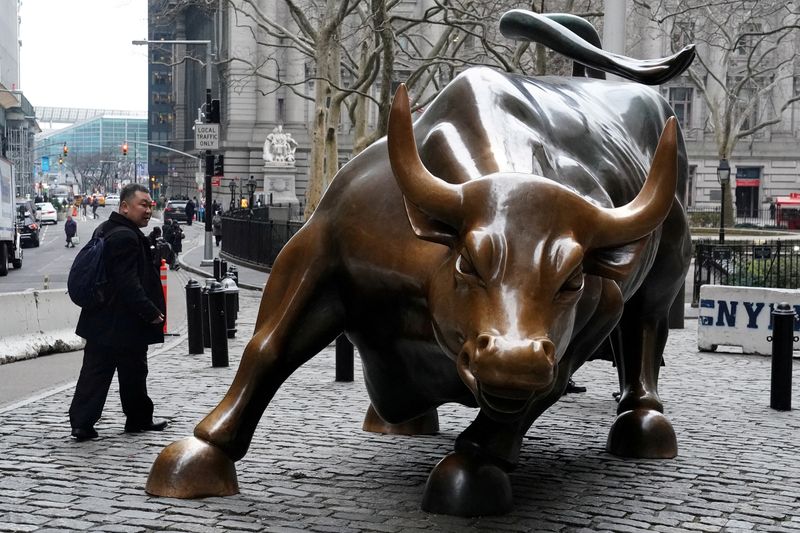By David Randall, Lewis Krauskopf and Carolina Mandl
(Reuters) -Hopes that an economic soft landing will lead the Federal Reserve to pull back on interest rates have ignited Wall Street’s appetite for stocks, despite concerns of slowing growth and the potential of an inflationary rebound in 2024.
The S&P 500 is up about 9% in November, on track for its biggest monthly gain since July 2022. Trends that had worried investors throughout 2023, such as the climbing dollar and elevated U.S. Treasury yields, are reversing, while the market’s most closely watched fear gauge stands near post-pandemic lows.
Two key assumptions are driving the moves. Investors increasingly expect the Fed to begin easing monetary policy in the first half of 2024, dispelling concerns that the central bank would keep rates "higher for longer." Rates futures markets are showing cuts being priced as early as May 2024, according to LSEG data.
At the same time, resilient data is leading to hopes for a so-called Goldilocks scenario, in which the U.S. economy emerges relatively unscathed from the 525 basis points of rate increases the Fed has delivered since March 2022.
Recent data, including reports showing slower job growth and cooling consumer prices "changed the narrative," said Jack Ablin, chief investment officer at Cresset Capital.
That has "increased confidence that we have seen a peak in the fed funds rate and we have seen a peak in inflation and we have seen a peak in the 10-year Treasury yield,” Ablin said.
The prospects for rate cuts received a boost on Tuesday after Fed Governor Christopher Waller, deemed a hawk, hinted at lower interest rates in the months ahead if inflation continued to ease.
Gross domestic product numbers for the third quarter, released on Wednesday, showed the U.S. economy grew faster than expected in the period, though momentum has appeared to wane as higher borrowing costs curb hiring and spending.
“Inflation has come down faster than the Fed expected and all signs are pointing to a soft landing,” said Jake Schurmeier, a portfolio manager with Harbor Capital. "If you were still betting on a recession coming, then the last few weeks have told you that the Fed is ready to respond and you will have to revise your expectations higher.”
The developments have accelerated declines in Treasury yields and the dollar, moves that could ease financial conditions and further stoke risk appetite if they are sustained.
The benchmark 10-year Treasury yield, which moves inversely to bond prices, was recently at about 4.3%, down about 70 basis points from 16-year highs hit last month. The dollar has fallen about 4% against a basket of major currencies since early October.
Meanwhile, the S&P 500 is up about 19% year-to-date and within striking distance of a fresh record high. The Cboe Volatility Index, known as Wall Street's fear gauge, stands at less than 13, near its lowest level since early 2020, before the COVID-19 pandemic.
Schurmeier said his team is in “active discussions” over how much to increase its allocation to small cap and emerging markets stocks that will benefit from falling rates.
To be sure, not everyone is convinced the Fed is done raising rates. Richmond Fed President Thomas Barkin on Wednesday said he is not willing to take the option of another rate hike off the table in case inflation flares again.
Given the expectations for significant cuts next year, anything less than that becomes a de facto “hike” to the market, "endangering the current optimism," said Charlie McElligott, managing director cross-asset strategy at Nomura Securities.
Some investors are also wary that the Fed's monetary tightening has yet to have its full impact and will eventually slow the economy more severely.
Deutsche Bank (ETR:DBKGn) economists on Monday projected 175 basis points in Fed rate cuts in 2024, but said that those cuts would come with a mild recession in the first half of next year. Nevertheless, the bank forecasts the S&P 500 hitting 5,100 for the end of next year, nearly 12% above its current level of 4,565.
Analysts at JPMorgan (NYSE:JPM) were more pessimistic.
“Absent rapid Fed easing, we expect a more challenging macro backdrop for stocks next year,” they wrote in a Wednesday report. “Equities are now richly valued with volatility near the historical low, while geopolitical and political risks remain elevated.”
The bank gave a 2024 price target of 4,200 for the S&P 500.
Others said investors may be overestimating how quickly the Fed might react to signs of slowing inflation.

Michael Green, chief strategist at Simplify Asset Management, said he is not adding more risk to his portfolios as he believes market participants have not started to incorporate some of the risks for the 2024 outlook.
“Unfortunately the odds are high that the Fed will be relatively slow to react to falling inflation unless it’s accompanied by a meaningful deterioration of the economy,” he said.